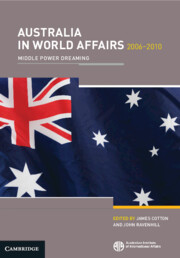Book contents
- Frontmatter
- Contents
- Tables, Figures and Boxes
- Contributors
- Preface
- Abbreviations
- 1 Middle Power Dreaming: Australian Foreign Policy during the Rudd–Gillard Governments
- 2 The Howard–Downer Legacy: Global Deputy, Regional Sheriff
- 3 Back from the Brink: Australia and the Global Economy 2006–10
- 4 Australia–America 2006–2010: Waiting for Obama
- 5 Australia and China: The Challenges to Forging a ‘True Friendship’
- 6 Australia and Japan: Mobilising the Bilateral Relationship
- 7 Australia and Europe
- 8 Australia’s Strategic and Commercial Engagement with South Asia under Kevin Rudd: The Paradoxes
- 9 Australia, the Pacific Islands and Timor-Leste
- 10 Progress and Limits in Regional Cooperation: Australia and Southeast Asia
- 11 Australian Foreign Policy towards Africa
- 12 Plus Ça Change? The Coalition, Labor and the Challenges of Environmental Foreign Policy
- 13 The Australia 2020 Summit as an Experiment in Foreign Policy-making
- 14 Defence and Security
- 15 Australia’s Foreign Policy Machinery
- 16 Regional, Alliance and Global Priorities of the Rudd–Gillard Governments
- References
- Index
15 - Australia’s Foreign Policy Machinery
Published online by Cambridge University Press: 04 May 2024
- Frontmatter
- Contents
- Tables, Figures and Boxes
- Contributors
- Preface
- Abbreviations
- 1 Middle Power Dreaming: Australian Foreign Policy during the Rudd–Gillard Governments
- 2 The Howard–Downer Legacy: Global Deputy, Regional Sheriff
- 3 Back from the Brink: Australia and the Global Economy 2006–10
- 4 Australia–America 2006–2010: Waiting for Obama
- 5 Australia and China: The Challenges to Forging a ‘True Friendship’
- 6 Australia and Japan: Mobilising the Bilateral Relationship
- 7 Australia and Europe
- 8 Australia’s Strategic and Commercial Engagement with South Asia under Kevin Rudd: The Paradoxes
- 9 Australia, the Pacific Islands and Timor-Leste
- 10 Progress and Limits in Regional Cooperation: Australia and Southeast Asia
- 11 Australian Foreign Policy towards Africa
- 12 Plus Ça Change? The Coalition, Labor and the Challenges of Environmental Foreign Policy
- 13 The Australia 2020 Summit as an Experiment in Foreign Policy-making
- 14 Defence and Security
- 15 Australia’s Foreign Policy Machinery
- 16 Regional, Alliance and Global Priorities of the Rudd–Gillard Governments
- References
- Index
Summary
The machinery of Australia’s foreign policy-making was transformed during the first decade of the twenty-first century, perhaps more profoundly than at any stage since the creation of an independent Department of External Affairs in November 1935. Until that time, the foreign affairs function of the Commonwealth government had been administered from within the Prime Minister’s Department. From its modest beginnings in 1935 in a clutch of rooms on the ground floor of Canberra’s West Block administrative building, the Department of External Affairs, then Foreign Affairs, then Foreign Affairs and Trade (DFAT) grew steadily in size and confidence. When DFAT moved into its imposing new headquarters on the edge of State Circle in 1996, it symbolised a coming of age of a powerful, confident bureau of state with full and independent stewardship of the nation’s foreign affairs. While prime ministers from Sir Robert Menzies to Paul Keating may have felt strongly about particular international causes, few questioned that DFAT and its ministers played the central role in initiating and implementing policy across the full suite of Australia’s international interests.
Keywords
- Type
- Chapter
- Information
- Australia in World Affairs 2006–2010Middle Power Dreaming, pp. 226 - 236Publisher: Cambridge University PressFirst published in: 2024

